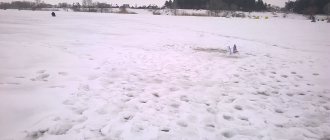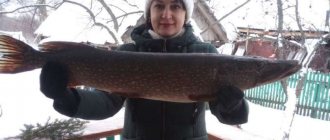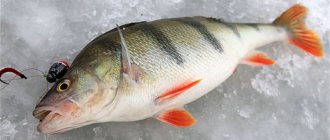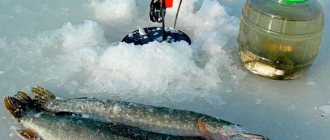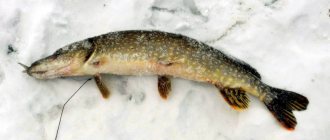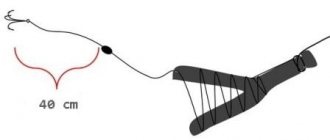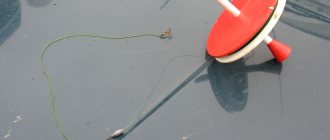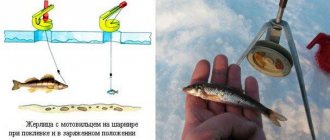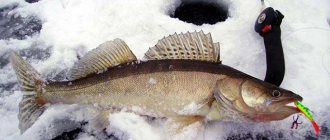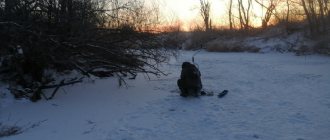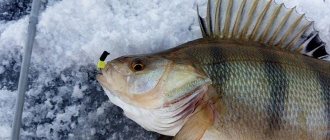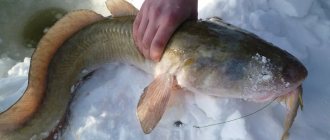Fishing with girders in the middle of nowhere. During the deep winter, the light and oxygen regimes change due to thick ice and a layer of snow. And not for the better. And if on rivers the current somehow struggles with this negative process, then on small stagnant reservoirs things are much worse. Deaths begin in lakes and swamps, leading to the death of a significant part of the fish population. The pike suffers no less than others.
In such conditions, the toothy predator becomes lethargic and passive, as evidenced by the “fringe” of leeches, which can often be seen on caught specimens during these difficult times. Small specimens are more mobile, but often they simply rip off the bait, disappointing anglers with idle flag raisings. But you have to wait for hours for a bite from a large predator in the middle of winter. She saves energy for the upcoming spawning; she comes out to feed once or twice a day and then only for a short time, so the chances of getting a trophy during this period are very slim. However, they are not hopeless. With the right approach, catching pike with girders in the middle of nowhere can also be successful.
Promising places for installing vents
At any other time of the year, the predator can randomly scour the entire reservoir, periodically attacking schools of fry, but not in January. In the deadest winter month, she will not waste precious energy on such walks. That is why it is necessary to know exactly the location of its parking lots. For this reason, experienced garrison fishermen prefer to travel only to well-studied lakes, river bays and reservoirs, where they know the depths, the nature of the bottom and even the location of individual snags and boulders lying on it. An echo sounder will help on unfamiliar bodies of water. True, with a loss of time, which is already lacking in winter fishing. But what should those who do not have this useful device do?
When you arrive at an unfamiliar river or lake, you should not rush to arrange your gear. First you need to look around and first of all pay attention to the coastal topography. If the shore is flat, dotted with small bushes and hummocks, this indicates that in this place there is an extensive shoal with a bottom surface as flat (like a plate). In such areas in the middle of winter, the chances of catching a scoring pike are minimal; at best, a miniature grass will bite. A steep cliff, on the contrary, indicates the presence of a deep hole or a nearby riverbed. It is precisely at the exits from pits and channel edges that the toothy one prefers to stand in the dead of winter. You can also see it biting near sources of fresh water - streams and springs that bring life-giving oxygen. Their presence is evidenced by ravines directed towards the water.
Practice shows that during the “dead” winter months the predator stays in the lower horizons in fairly deep areas with a relief bottom. It can wait for prey, hiding under a riverbed, behind a boulder or a submerged snag. It moves only when it is chasing a school of food fish, along the same routes, but in most cases the toothy one still prefers to sit in ambush. This is confirmed by the work of the girders. A successfully placed fishing tackle “shoots” several times, while the nearest fishing rods remain stubbornly silent. Moreover, they are all exposed in one promising area and at the same depth.
There is no point in placing gear where the pike was fattening on the first ice. That is, in the coastal zone that is overgrown in summer. Now the vegetation, the main consumer of oxygen, is decomposing here with all its might, and the predator avoids such places.
Perch fishing in February
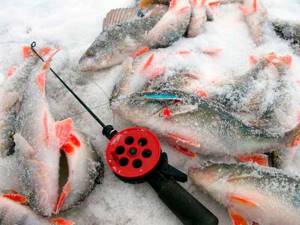
The best tackle for catching perch was and remains a jig. If the bite is active, then you can fish without a reel, relying solely on the game of the “goat”, “devil”, etc. But if the fish is sluggish, then it is better to use ordinary jig tackle with the addition of bloodworms, maggots, a piece of worm, burdock moth larvae, etc. The perch bite in February improves from the middle of the month. At this time, you should look for him in places familiar to the striped robber:
- where a river or stream flows into a body of water;
- among snags and underwater thickets;
- on holes and depth changes.
They lure perch vertically using small baits, usually oblong in shape. It is better if the spoon does not twitch chaotically in the hole, but glides smoothly through the water, attracting the attention of a perch swimming nearby. Most often, the blow follows after the spoon has dropped to the bottom, where the angler must let it “rest” for a few seconds before he begins to lift it to the hole again. This is interesting: Fishing tackle for perch “Balda”
Small balancers, which have been successfully used by fishermen for a long time, have proven themselves to be quite good when catching perch. True, balancers have one big disadvantage - they “love” to cling with the lower tee to all sorts of underwater obstacles - snags, algae, sunken objects, etc. In this case, it is recommended to remove the bottom hook, which naturally affects the amount of catch. Read also: The best balancers for perch
Perch fishing: ratlins and jigs
Release time
Pike feed according to their daily schedule, which resembles a regular bus schedule. If in summer it is quite dense, then in the dead of winter, on the contrary, the toothy one goes out hunting very rarely. Throughout the daylight hours, she may show interest in food for no more than 30 minutes. It is almost impossible to guess when this will happen. The time the spotted beauty comes out depends on many factors, such as her mood, weather, oxygen level in the water and others. If during this short interval the bait does not appear in its path, then the chances of capture are negligible.
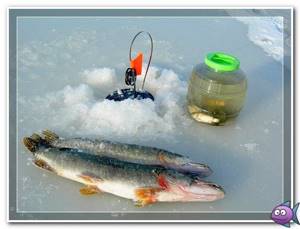
Observant garrisons note that in some reservoirs, in the period from mid-January to the end of February, outbreaks of more or less active biting are observed at dawn. On some rivers and lakes, pike are interested in live bait from sunrise until 9-10 am. As a rule, with such a long-lasting bite, it pleases anglers during multi-day thaws, which are not uncommon in recent years. As for the toothy’s evening outings, you shouldn’t count on them in the “dead” winter months. In the evening, the passive predator, full of eggs, rarely makes itself known, and if it does bite, it is very sluggish. Usually, after raising the flag, without waiting for the second unwinding of the reel, the fisherman lifts only a slightly bitten baitfish onto the ice.
Fishing for girders - where to look for pike in spring?
It is better to look for pike on the last ice at shallow depths. The experience of garrison fishermen shows that it is possible to catch a trophy even at a depth of 20 - 40 cm from the lower edge of the ice. It’s worth trying to look for it along the coastal polynya and on the edges if you know the body of water well or have done reconnaissance in advance.
It is advisable to place the zherlitsa at a distance of 15 - 20 meters from each other. Some people use a “chessboard” layout. This method is great for fishing on the edge, in order to catch the upper and lower zones at once. Pay attention to reeds and reeds; such places should also be checked.
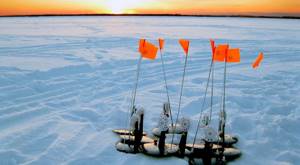
The main thing is not to stay in one place. If there is no bite on the bait within an hour or two, change the location. After the “working”, on the contrary, put on a new live bait and wait for another “spotted beauty”. There is a chance that the flag will “light up” again.
However, the most effective search for pike is joint fishing with an experienced pike fisherman who knows the reservoir. Still, it’s quite difficult for yourself to come to an unfamiliar fishing spot for the first time, immediately put the girders in the right places and get the “work.” And the ice is too thick for active reconnaissance on such a scale. If possible, find such a person before fishing.
Equipping the girders in January-February
Given the high capriciousness of pike at this time of year, anglers replace individual elements of gear. For example, instead of a main fishing line with a thickness of 0.40 mm, a thinner one with a diameter of 0.30 or 0.35 mm is used. It is better to completely abandon a metal leash in the middle of nowhere. Of course, in this case there is a risk of an annoying cut, but with a leash you can’t expect any bites at all. Nowadays, many bait fishermen fish with fluorocarbon leaders, which are not visible in the water, regardless of thickness. Thick fluorocarbon is too much for a half-asleep pike.
Particular attention should be paid to the tee. The hook must be hooky, that is, very sharp. Such a hook will pierce the fish with any careless movement, even if it does not swallow the bait. Often pikes are caught in a strange way when the tee goes outside, and not inside the mouth. By the way, tees can also be placed in smaller sizes so that they do not frighten the predator.
Some fishermen fish with double hooks by threading a leader through the gills of the fish. With this method of baiting, the double sticks out from the baitfish’s mouth, which is why the latter does not live long. Frankly speaking, this is not the best way to seduce a lazy winter pike.
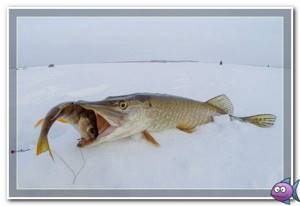
Selection of girder equipment. How to make a zherlitsa with your own hands.
Zherlitsa is the main and most common way of catching pike in winter. The best design for a pike trap is the traditional one, with a round plate covering the hole and a signaling flag. This design allows you not only to use all kinds of equipment, flexible settings, change the sensitivity of the equipment, but also to track the bite.
Monitoring the bite on a girder in winter fishing is one of the keys to success. Pike behave cautiously in winter and take their prey slowly. After she grabs the bait crosswise, she turns it around in her mouth with its tail facing outward and swallows it from the head. He also swallows slowly, not like in the summer. She has enough time to feel the hook, the rough wire leader, prick and spit out the bait. Therefore, the fisherman must run up in time and make a hook. In this case, the fish will not come off.
However, girders designed for self-notching are often used. These are easy to make yourself, while ordinary flags with flags are easier to buy. The simplest girder is a stick laid across the hole, to which is tied a piece of thick wire and then a fishing line with live bait equipment. The wire is needed so that when the hole freezes, it can be cleaned with an pick, a hatchet or a knife without fear of cutting the line.
Regarding the equipment of the girder, it must be said that it should be as simple as possible. Be sure to install a leash that the pike cannot bite through. It is best to use flexible ones made of leash material, but at worst, ordinary wire ones will do. The hook is usually set with two treble hooks, large enough to cut the pike's mouth through the cartilage. With two hooks, she practically cannot pick off live bait with impunity; there will be fewer fish runs and empty bites than with one.
It is best to mount the fish by the edge of the dorsal fin, anal fin, or lips, avoiding damaging large bones or organs, but so that it cannot be torn off. You should not use tackle that passes through the gills and supposedly does not injure live bait. In fact, live bait runs much less on them than when baited by the fin, since damage to the gills is more painful for the fish than damage to the sponges or fin, and it also interferes with breathing.
Tactics of fishing with girders
In the middle of winter, the toothy predator is inactive. She saves energy, but she still has to eat to maintain her strength. If live bait is right in front of her nose, she will not miss the opportunity to have a snack with minimal calories. This behavior of the fished object requires some changes in fishing tactics. On the first ice, the girders are placed at a distance of 10-15 meters from one another in order to cover a larger area. In the wilderness, it is advisable to reduce this distance to 5-6 meters. Why? A lazy pike, of course, will feel the vibrations created by live bait at a greater distance, but it is unlikely to want to overcome it in order to get closer to the prey. It’s another matter when the fish is close, almost at throwing distance. In addition, the grouping of the girders allows you to monitor them more closely, which is also important in January-February. During this period, the bites are so weak that the flag does not work.

Search and tactics for catching pike with flags in February
So, pike fishing for zherlitsa in February depends on whether the pre-spring activation of the predator has begun or not. A logical question is where to look for pike in February using girders. It all depends on the region, the type of reservoir and the specific characteristics of this water body.
Catching pike in February with girders in lakes and ponds that do not have tributaries, most likely with passive pike. Spring changes occur late in such reservoirs. However, during prolonged thaws you can count on a good catch here too. In reservoirs, the toothy one emerges from winter hibernation earlier - it needs time to gain strength before the spring spawning migrations.
Catching other predatory species
For some reason, many winter fishermen associate the girder only with pike, but in reality it is a universal tackle that can be used to successfully catch large perch or burbot. By the way, the cold-loving burbot, unlike the toothy burbot, does not “mope” at all at this time of year. It loves low temperatures so much that it even spawns in the dead of winter. Before and after the spawn, burbot is more active than ever, so if things don’t work out with pike, it’s worth looking for fishing luck in those reservoirs where this predator lives. The zherlitsa is the most effective tackle for catching burbot from the ice. Many winter fishing enthusiasts have already become convinced of this.
Other fishing methods
In addition to the girdle, there are many other ways to catch pike.
On the crab
For the European part of Russia, the method is quite exotic. However, it is widely used in the Far East and Siberia. Crab is a special bait like a balancer, but flattened on top and having three or four hooks extending in different directions. The crab's game is very unique; it persists throughout the current. They are caught at shallow depths, up to two meters, in places where the current is not too fast.
To the balancer
Fishing with a balance beam is more familiar to fishermen and is practiced both abroad and in Russia. The pike balancer should have a fairly sharp stroke. Even in shallow water, they use large mass balancers that move away, quickly return, and some even make a double or triple loop. The optimal shape of the balancer is with a flat head, “fin” type or similar. Often they use a balancer with a metal tail, because the pike takes the bait quite sharply and bites off the tail.
The balancer must be inserted through the fastener and a strong leash must be used. The fishing line used is one that can be used to easily get a pike into the hole.
This is usually much more difficult than with perch because the fish is long. If the fishing line is thin, then winding it, and even with a wide balancer in the mouth, will be difficult, and there will be a lot of slips. A hook that you have to constantly carry with you, as well as a 150 mm ice auger, saves you from derailments.
For the spinner
Nowadays, lure fishing is rarely used, since in terms of effectiveness for pike, lures are inferior to balancers, rattlins and other modern lures. However, if you want to “remember the old days,” you can fish with summer spoons, playing with them like glider spoons. The “shtorleg” and “rapala” spinners perform well in this capacity; they have a center of gravity in the center of the resistance area, play well when falling and rarely get caught in the fishing line when tossing.
